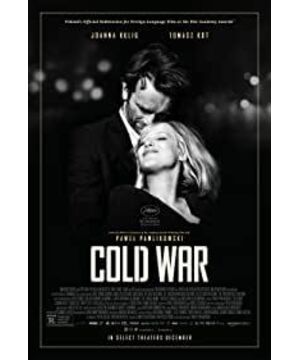Black-and-white films can never be called products eliminated from color films.
This black and white film is about Poland during the Cold War.
The iron curtain of opposing systems is resolute and heavy, and the quiet environment is serious and indifferent.
Everything is as cool as the Vistula River, flowing through the entire territory of Poland, soaking in the cold.
The sun is black and white, and there is no temperature. Stalin's poster is black and white, solemn and solemn.
On the corner of the street, the male lead burned out the last cigarette, and the white smoke that he spit out was wrapped in waiting, rising into the dark night.
After all he could not wait for his love, squeeze out his cigarette, and walk towards the military border. There is another system over there, without turning his head, his back is also black and white.
This black and white is as cold as the times.
The movie is called [Cold War] and it has just won the Cannes Film Festival this year.
And six years ago, it was also a black-and-white film [artist] that won the Oscar.
Hundreds of years of film history are intriguing. When color has become the instinct of the eyes, black and white are extremely dazzling.
To this day, people are still shooting and watching black and white movies.
This technology, which now seems quite aging, seems to have never been out of date.
To talk about how enduring black-and-white films are, one must start with color films.
The public generally believes that color movies are later stories. In fact, when movies are first born, they have color.
It's just that the meeting is not based on color film, but hand-painted frame by frame on black and white film. Color film is like a hybrid between painting and film.
It is no wonder that the industry does not recognize this as a color film.
Because the colors are artificially painted, the colors are not realistic, they are just gimmicks, and black and white still have absolute dominance on the screen.
It wasn't until the emergence of color film in the 1930s that the first color film recognized by the history of filming did not make its mark.
But [Flashy World] is not like [Jazz Singer] back then, which brought a revolution to the movie, but only opened the prelude to the screen color and black and white see-saw.
Mainly because the new color film technology is troublesome to produce, and the cost is still high.
In 1936, a report of the Illumination Committee of the American Society of Motion Picture Engineers pointed out that only 250-400 light intensity is required for black-and-white film production, while color films are as high as 800-1000.
It is said that when [The Wizard of Oz] was filmed in 1939, the temperature in the studio was as high as 38 degrees due to the high power and quantity of the lighting equipment, and the characters had to put water bags in the costumes to cool down.
In order to prevent the equipment from overheating, the staff often used water guns to spray. After the filming, some actors complained of permanent damage to their eyes.
In addition, in the same year, there was also a "Gone with the Wind" , which almost bankrupted MGM with the production costs alone.
It can be seen that the ability to produce color movies is equivalent to today's full-process CGI special effects, and only large companies have this financial and material resources.
The technology is immature and the cost is uncontrollable. In the first few years when color films were born, black and white films were still on the market.
However, these have been accompanied by the rapid economic development of the United States after World War II and have gradually become less of a problem.
As of the end of the 1940s, the output of color films in the United States had accounted for 51% of the market, and it seemed to be evenly split with black and white films.
It's just that the good times don't last long.
In the 1950s, television began to become popular, and major film companies had a foreboding that it was the future, and they reselled their films to television channels for broadcast.
Since there were only black-and-white TVs at that time, major companies turned their focus to black-and-white movies. Color movies fell out of favor once again, and their market share once fell back to 21%.
It wasn't until the mid-1960s that color TVs entered thousands of households, and Kodak made revolutionary improvements to color film technology, and color films really ushered in a full-blown explosion.
Since then, black and white movies have begun to walk down the altar.
In the late 1970s, a group of well-known Hollywood directors set off a counterattack against black and white films because they were afraid that the preservation of color films was far less than black and white.
People who want to come to Woody Allen's [Manhattan], Martin Scorsese [Angry Bull] and David Lynch's [Elephant Man] are all from this period.
The counterattack is only temporary. The digital film that was born in the 1980s completely lost the competitiveness of black and white film.
Although it is the last laugh in color movies, looking at the history of eye shadow, black and white movies have never been outdated.
In 1998, when Christopher Nolan made his debut [Follow] , he only had a budget of $6,000.
In addition to self-editing, self-directing and part-time photography, in order to control costs, it is shot in black and white.
Compared with color films, cost is always a huge advantage of black and white films, but this is not the reason for its long standing history.
Just like blind people who have lost their vision strengthen other senses, black and white films without color language have unparalleled light and shadow.
And this is the soul of black and white films.
With the help of lighting techniques, black and white have a very high contrast, which can effectively hide or highlight information, making the plot more tense.
This is harmless to the narrative-based drama, followed by the picture.
[Scary] The classic bathroom murder has benefited a lot. Under the black and white light and shadow, the identity of the murderer is hidden, and the victim's struggle is more prominent, ensuring suspense without losing terror.
At the same time, the alternation of light and shadow can also hint at the inner change of the character.
And Kurosawa Akira's [Rashomon] is particularly prominent.
The leaves split the light and shadow, and cast mottled black and white on the face of the character, which strengthens the character's complex character and points to the unbelievable human nature of the film theme.
In addition to the above-mentioned functions of deepening the plot, black and white light and shadow can often express the mood of the movie.
For war movies, black and white can give realness and dignity to the movies, such as Lu Chuan's [Nanjing! Nanjing! ] , Black and White is full of anger and accusations in the film.
Or [Cold War], the depression and coldness of that era can only be expressed in black and white.
Furthermore, some scenes will have a special look and feel in black and white films, and the colors are superfluous.
The most vivid example is smoke, which is white by itself, and is decorated with light, and the layers are fully displayed, which is perfect.
There are also the most beautiful smoking shots in the black and white film. The smoke lingers, the light and shadow are engulfed, and all kinds of emotions can reach the extreme in an instant.
In addition, there is plasma. After being processed in black and white, it reduces the physical aversion and gives birth to a violent aesthetic.
Quentin slipped out of the black and white clips in [Kill Bill].
Because of this, black-and-white films can never be called products eliminated from color films.
It is more of an equivalent type to the latter, with a unique texture on the screen.
It is precisely because of these characteristics of black and white films that, in order to improve the performance effect, some color films have begun to blend into black and white in a targeted manner, but they are also exceptionally harmonious.
In this way, black-and-white films transformed from genre to expressive technique, and found the most appropriate way of existence.
In this application, black and white are most commonly used to distinguish two different states.
For example, Nolan's second feature film [memory fragment] .
The debut film took the advantage of black and white. Although [Memory Fragment] had sufficient funds, Nolan chose to make the movie into a black and white color mix.
In the film, black and white and color represent the difference in the timeline. Color is flashback, black and white is chronological. As the colors flow, the story of the grass snake gray line slowly becomes clear.
In [US X File] , black and white is the hero’s past, a gloomy life, and color is the revolutionary present.
The contrast between the two tones makes the protagonist's mood change obvious.
In [Happy Together] , the color turned into Li Yaohui's mood. When we broke up, it was black and white. It wasn't until He Baorong came back that there was color.
Since there are color films mixed with black and white, there must be black and white films grafted with color.
Unlike the former, the colors in black and white films mostly refer to strong symbols.
The audience can hardly forget the girl in red in [Schindler's List] , because in the black and white ruins, she is so red that she is the hope of life.
In the playful [Big Buddha Plus] , the colorful world in the driving recorder pushes the black humorous irony to the extreme.
The same color is given to the fish in Coppola [Betta fish] .
That is the color of youth and youth, and also his inner desire to escape from the town and yearn for freedom. After all, these two sound more colorful than this black and white gloomy town.
Whether it is pure black and white resurgence, or half-mixed prevalence, all tell the audience that black and white movies have never faded out of film history.
The charm that can be said but cannot be replaced is the reason why people are still photographing and looking at it nowadays.
As Paviu filmed [Cold War].
He always knew that to load the love and the absurd times that his fathers could not let go, there was only this light and shadow, 24 frames per second in black and white.
After the [Cold War], people seemed to have another reason to watch black-and-white movies.
-
Author/Yaoyao Wine
The article was first published on the WeChat public account "Pocier"
View more about Cold War reviews











